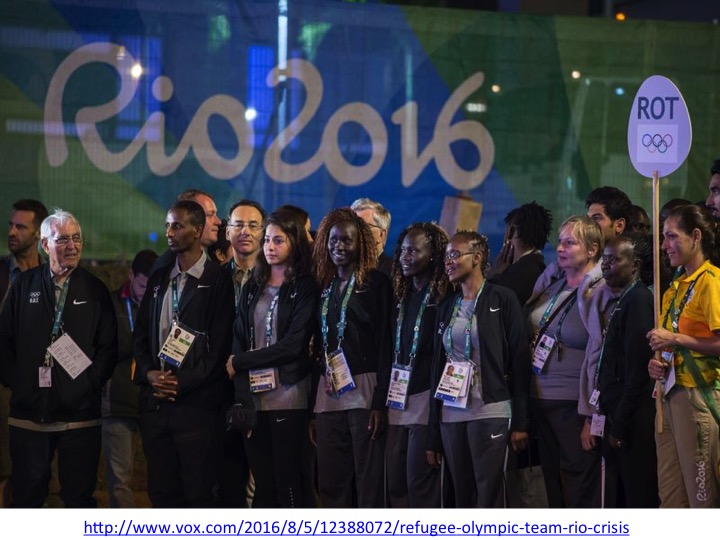Swiss Junior Doctors and Undergraduate Perspective on Sport and Exercise Medicine Blog Series
By Artiom Ganchine, @ArtiomGanchine
With the contribution of Justin Carrard, @Carrard.Justin
The world is facing the biggest refugee crisis since World War II. In 2015 and according to the office of the United Nations High Commissioner for Refugees (UNHCR), about 63 million people across the world were forced from their homes1 .They are fleeing war, famine, and other man-made and natural disasters2. Consequently, the International Olympic Committee (IOC) created a Refugee Olympic Team (ROT) to “raise awareness of the magnitude of the refugee crisis”. The IOC President, Thomas Bach, said: “These great athletes will show everyone that, despite the unimaginable tragedies that they have faced, anyone can contribute to society through their talent, and most importantly, through the strength of the human spirit”2. The IOC, together with National Olympic Committees, International Federations and the UNHCR selected athletes with refugee status and Olympic level skill. Ten athletes were chosen (two swimmers, one marathoner, five middle-distance runners and two judokas) to take part in the 2016 Olympic Games in Rio3.

I recently met up with Dr Carlo Bagutti4, who was the elected ROT (Refugee Olympic Team) Chief Medical Officer. He is also a Sports Physician in Lausanne (Switzerland), a team doctor for Swiss Athletics and a member of the IOC Athletes’ entourage commission5. I had the great pleasure of interviewing him. You can see from his responses how diverse and humanly enriching Sports and Exercise Medicine can be.
Dr Bagutti, first thank you for accepting the interview. Could you explain to us – how, if at all, was it different to work with the refugee athletes in comparison to the athletes you usually work with?
The first difference was a psychological one. The medical team has to help the ROT athletes to keep focused on the competition despite the breadth and richness of the new experiences they faced during the Games. To understand this point, you should try to imagine the life and training conditions of South Soudan athletes in a closed camp in Kenya or those of the two Congolese judokas in one of Rio Favelas. Most of the athletes were not familiar with all the facilities and material wealth you can enjoy for free in the Olympic Village. Others had never seen an athletic track before. In such a situation, you can easily imagine, that it is not simple to keep focused on the competition.
Secondly, the marginalized social status of these athletes transformed to a beacon of hope for all refugees across the world. The Syrian refugee Yusra Mardini said it very well at the 129th IOC session: “We still are humans. We are not only refugees. We are like everyone in the world. We can do something. We can achieve something”2.
On a clinical angle, did you have to deal with atypical pathologies?
They came with two kinds of problems, which I usually do not treat in big competitions. Firstly, some of them had dental health issues. Secondly and more interestingly, most of them suffered from overuse injuries (mainly tendinopathies). Only having 6 months to train for the Olympics, all of them trained hard in order to proudly represent all the refugees around the world. Additionally, some of them presented uncorrected basic biomechanic issues, as they did not have the opportunity to follow high quality training and lacked adequate sporting material.
What in particular, left an impression on you?
I was really pleased by the interest that other athletes and the media showed for the ROT. A lot of athletes and journalists visited us, mainly because the ROT spread a positive message in a more complicated political context such as the Russian doping scandal, the ticketing corruption issue, and the Brazilian internal political crisis.
If you had the opportunity to repeat this experience, would you go for it?
Yes, without any hesitation. I wish that all my colleagues could have such a rewarding human and clinical experience.
In that way, would you recommend to a medical student to shadow a sport physician on the sporting field? If yes, which postgraduate rotations would you counsel in that case?
Firstly, I encourage all SEM interested medical students to embrace a SEM career because it is a varied and very stimulating specialty, which offers a lot of intellectual and human challenges.
Secondly, I would definitely recommend shadowing. In my opinion, academic training is not enough to become a sports physician. One should know the sport in which they are practicing in order to better understand and treat the pathologies. In that way, I advise to both practice the sport in question and to go on the field.
Concerning the postgraduate training, I recommend a broad clinical training including internal general medicine and physical medicine and rehabilitation rotations. This is because athletes see us for a large variety of issues. Even having a background in psychiatry could be very useful.
—
To learn more about ROT, as well as the projects the IOC is currently conducting to help refugee through the practice of sport, we highly recommend you the following links:
- https://www.olympic.org/news/refugee-olympic-team-to-shine-spotlight-on-worldwide-refugee-crisis
- https://www.olympic.org/news/sport-comes-to-the-aid-of-refugees-as-nocs-make-use-of-ioc-s-usd-2-million-fund
*******************************
Artiom Ganchine (@ArtiomGanchine) is a third year Swiss medical student (Geneva, Switzerland) with a keen interest for SEM. Outside of medicine, he enjoys cycling, running, trail running and participates in competitions in all of these disciplines. Contact: ganchine.artiom@gmail.com; Twitter: @ArtiomGanchine
Justin Carrard (@Carrard.Justin) is a first year internal medicine resident based in Biel/Bienne (Switzerland). He is the newly appointed Swiss Correspondent for the brand new BJSM Swiss Junior Doctors and Undergraduate Perspective Blog Series. If you would like to contribute to the “Swiss Junior Doctors and Undergraduate Perspective on Sport and Exercice Medicine” Blog Series please email justin.carrard@gmail.com, or tweet @Carrard.Justin for further information.
References
- http://www.unhcr.org/figures-at-a-glance.html
- https://www.olympic.org/news/refugee-olympic-athletes-deliver-message-of-hope-for-displaced-people
- https://blogs.bmj.com/bjsm/2016/06/01/counting-down-to-rio-2016-with-the-olympics-special-edition-a-bjsm-treat/
- http://www.vidysport.ch/equipe-bagutti.html
- https://www.olympic.org/athletes-entourage-commission